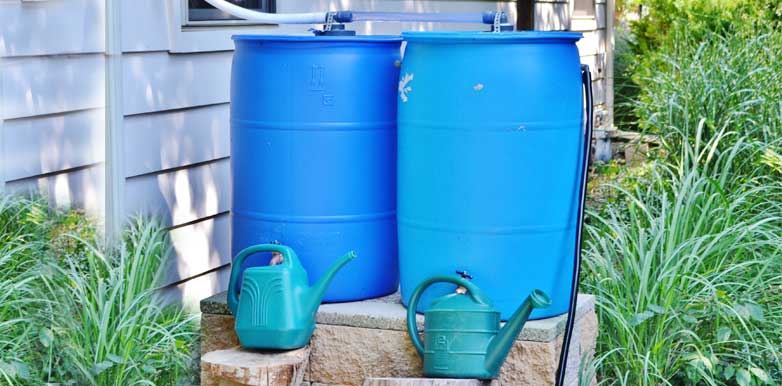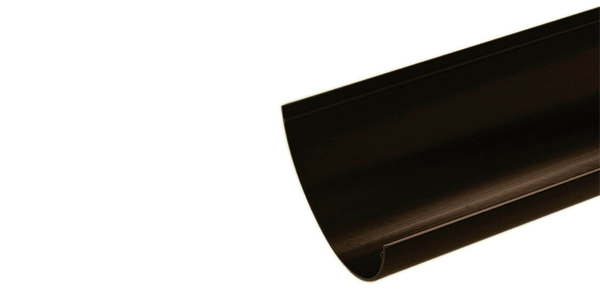How to Collect Water from Your Guttering System

What a contrast this summer is to last! With clever weather people estimating that we had a month’s worth of rainfall in one day alone, it’s certainly a typical British summer.
But it’s not all bad, without the rainfall we have we wouldn’t have the lush green country that we call home. Plus, it’s the perfect opportunity to save some water for the garden just in case there is a change in the weather and we still get hose pipe bans this summer after all.
All those keen gardeners out there will also know that there are many plants that prefer to be fed rainwater to tap water. They prefer acidic conditions and tap water can raise the PH level of the soil, a good example of such a plant are blueberry bushes – they love rainwater!
We bet you didn't know that you can collect as much as 24,000 litres (that’s 150 water butts worth!) of rainwater from a typical house roof in just one year? To get the most out of the rainfall, however, you'll need to make sure that your guttering is all in good working order. You'll also want to ensure that it’s not only in place around your house but also around any garden buildings such as your summerhouse or shed.

In this article, we'll delve into some of the issues that may be impacting the effectiveness of your guttering. These ranges from simply blockages to missing parts. We'll also share some tips on installing guttering around your home and how to make the most of your reserved water.
Blocked Gutter or Running Outlet
It’s advisable to clear your gutters of leaves, moss and debris each year to avoid blockages plus they’re great to add to the compost heap! If you’re clearing the guttering on your house, you may want to get some help from a handyman or contractor.
But if you’re clearing the guttering on a summerhouse or shed and want to do it yourself, here’s a simple ‘How to’ guide.
How to Clear Your Gutters
- Push an old rag into the top of the downpipe to avoid pushing any of the leaves down there whilst you clear the gutter out
- Use a scoop (a plastic milk bottle cut in half so that you have a scoop with a handle that works well) or simply some sturdy gloves and your hands to remove all the leaves and debris
- Remove the rag and that’s it - you’re done
- To avoid it happening again fix a leaf guard onto the guttering
Missing Stop end
If you find water flowing off the end of your guttering, then it’s quite likely that you’re missing a stop end. This can lead to moisture damaging a nearby wall or the ground below becoming incredibly damp. Luckily, they’re easy to replace:
Replace a Missing Gutter Stop End Outlet
- Measure the width, height and depth of your guttering and purchase a new Stop End Outlet to fit
- Remove the clip at the end of the stop end outlet
- Insert the guttering pipe into the stop end outlet
- Reclip the clip on, holding the guttering pipe in place
- Push the down pipe (or offset bend if you have one) into the stop end outlet
- If you’re fascia is longer simply extend the stop end outlet with a piece of down pipe before slotting the offset bend on
Replace a missing Gutter Stop End
- Ensure that the stop end outlet is clean and dust free, if need be, gently sand it and wipe it with a cloth
- Apply gutter sealant to the end cap and push it onto the stop end outlet
- Using crimpers, crimp the end cap in place, crimp twice on the bottom, two on the side that will be nearer the roof and once on the exterior side
- Apply a beading of gutter glue around the inside of the stop end cap, where it joins the gutter and smooth the beading down with a finger

Installing New Guttering
If your summer house or shed doesn’t have any guttering, follow the instructions below and start collecting rainwater (it’ll also mean that your summer house or shed is less damaged by the rain):
How to Install New Guttering
- Fit the Gutter End Bracket just below the facia at one side of the shed using brackets
- Position the Gutter Stop End Outlet where the downpipe will be (usually at the other end of the shed), this must be slightly lower than the Gutter End Cap to allow the captured rainwater to flow
- Attach some string to the End Cap and run it to the Gutter Outlet as a guide to where to attach the other supporting brackets
- Attach the supporting brackets evenly between the End Cap and the End Bracket at a maximum of 80cm apart
- Fix the Guttering from the End Cap to the Gutter Outlet, by tilting the guttering onto the brackets to fit under the back clip and snapping it in place at the front
- Fix a Stop End to the Guttering at the End Bracket using some silicone lubricant and clipping it in place
- Attach the Guttering into place at the other end of the shed by clipping it onto the Gutter Outlet
- Next, line up where the Downpipe brackets are to go by adding weight to a piece of string and dropping it down the Gutter Outlet
- Secure the Offset Bend to the Gutter Outlet using a bracket, securing within 150mm from the fitting
- Attach the Downpipe using brackets with a maximum of 80cm apart
- If you need additional parts of the Downpipe use socket and pipe clips to clip them onto the downpipe
- Fit a Gutter Shoe at the end of the downpipe using a bracket or fix the Downpipe directly to a water butt
Getting Clever in Your Garden
Now that your guttering is working correctly you can utilise the rain water and get experimental in the garden with your newfound supply of water.
Try setting up a clever drip irrigation system from your water butt. Irrigation systems are brilliant if you can’t get to water your garden or allotment every day or if you have lots of plants and you just want to cut the watering time down!
You can also make sure that you collect as much rainwater as possible by having a rain collection system in place with connecting water butts, so that once one fills it overflows into the next and so on.
Another idea is if you have a small garden, or are simply a keen gardener and want to use every inch, grow water loving plants that don’t mind getting their roots wet like chard or Bok Choy directly on top of the water butt. Here’s how:
How to Grow Veggies on Top of Your Water Butt:
- Simply set the water butt lid to one side
- Attach some mesh or cheap loosely woven fabric to the top of the water butt
- Wait until the water butt is full of water
- Plant Bok Choy, Chard or other water loving plants onto the top of the fabric/mesh and their roots will grow down into the water
Just remember to clean out the water butt once a year to get rid of stagnant water to prevent disease spread.
If you have any other inventive ways to use the rainwater you collect from your guttering, please do let us know – we’d love to hear all about it or see some pictures. You can contact us or share your idea on our Facebook page.
You can also browse our full range of guttering online which includes a vast range of materials, including modern UPVC, steel, and copper, all in a range of profiles, providing a solution to whatever aesthetic you aim to achieve.